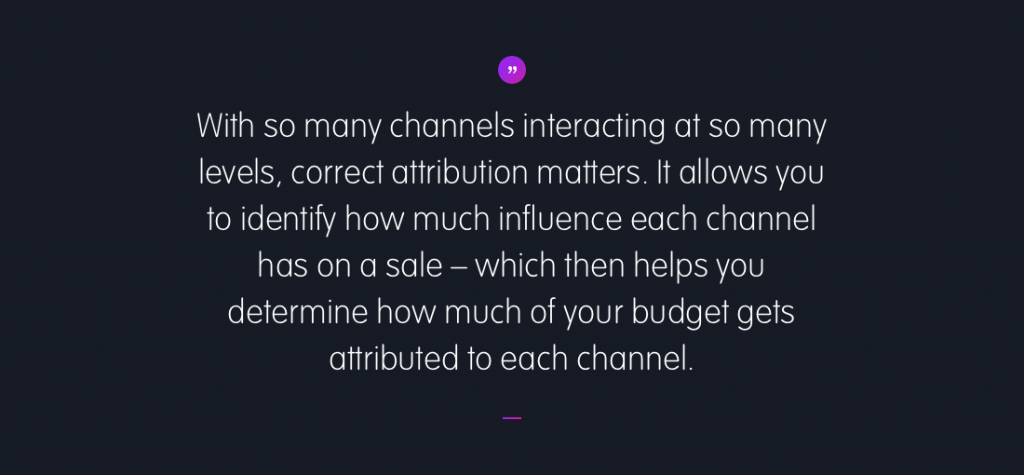The benefits of having an in-house marketing team are easily listed.
- It’s cheaper – if you hire directly, you’re not paying for talent plus agency overhead
- They can respond faster to shorter deadlines – the speed of turnaround is significantly reduced
- They won’t need to be educated on every brief – because your business is the only business they’ll be working on – in theory, reducing briefing time and reducing the need for briefs on small jobs
- They won’t be distracted on other clients – you won’t be a small fish in a big pond, you’ll be the only fish in the pond
And, while there are real benefits to having an internal team, there are also significant dangers. We explore the biggest mistakes marketing teams make.
The five biggest mistakes we see businesses making are:
- They try and take it all in house
- They hire specialists when they need generalists
- They treat channels as siloes
- They don’t know what data they need, or how to attribute it.
- They assume external agencies are extensions of internal ones.
1: You try and take it all in house
Don’t.
Unless you’re a start-up and you have access to a unicorn who’s an expert at everything and can do it all themselves. And if you do find one, ask yourself why this magical creature is being allowed to roam free when larger businesses with much bigger nets would be able to feed it more than you ever could?
Here are the big issues.
Some functions are best kept at arm’s length.
Even the biggest businesses, international corporations with massive budgets, hire external specialist businesses for specific jobs.
You can’t fire an internal agency.
If they’re not exceeding expectations, if they’re not good enough, if they continually do what other departments want at the expense of your brand or your strategy, or if you just need a second opinion because you believe an email campaign isn’t going to work as an awareness initiative, how do you get rid of them?

It can be slower.
It seems counterintuitive, but external delivery can be faster. Many businesses are faced with the all-too-common dilemma of choosing between “cheaper” and “more effective”.
And, in many cases, they choose cheaper, because they assume the short term cost results in a long term saving. As a rule, it doesn’t. If you only have one specialist, and they have five current projects, and you want to add your project to their pile, it may be easier to brief out one or two of those, or your own, to get it done.
If you’re inside the office, you can’t see the street.
External digital marketing specialists give you external perspectives. They tend to be more current on specialist developments across industries and across business a rule.
You’re more likely to get insights of real value, and a current view of changing customer needs, from someone who isn’t distracted by internal deadlines. Hire the specialist when you need them and make sure you get as much external perspective as you can from them.
Can you afford to keep them?
Specialists are like thoroughbred horses. Or purebred dogs. They need a lot of attention. And they tend to need specialist tools to live up to expectations.
External specialist agencies can do that because external specialist agencies tend to get a lot of specialist work. If you can’t keep your specialist busy on specialist work you’ll either have to turn them into generalists (to justify the spend) or fire them. Or they’ll go somewhere else, where they get their specialist needs fulfilled.

2: You choose a specialist when you need a generalist
Your need for generalist or specialist functions depends on the size of your internal team, its structure and the desired output of the team.
As a rule, generalists are better at seeing the bigger picture.
Specialists have a deep knowledge of one area and should, properly briefed and managed, be able to deliver a much better final product than a generalist ever could.
Remember, “I can do that” is not the same as, “I can do that, and add things you don’t even know about to make it brilliant.”
Specialists cost more. But a good specialist more than makes up for the cost difference.
If you’re a start-up, you need a generalist. You need someone who’s reasonably good at most things, but knows enough to know they don’t know everything. Give them a reasonable budget and let them come back to you with a plan on you’re your money should be spent.
If you have a small internal team, and you’re using outside agencies to deliver any services – from sitecore SEO to content to strategy – you probably need to hire generalists to manage the specialists who’ll be delivering those services.
If you have a medium to a large team and they are required to meet the bulk of your business’s marketing output, identify where the specialist money is best spent (this will depend on your specific needs) and where the generalist money will add the most value.

What’s the difference?
Specialists are gurus.
To paraphrase Liam Neeson, they have a very specific set of skills. They don’t see the bigger picture, but they know how their skillset adds value.
They have a deep knowledge of a specific area. Take SEO for instance. An SEO specialist will know about SEO, will understand the latest influences on SEO strategies, and how the changes to digital platforms and algorithms affect SEO goals.
They will understand why SEO matters and how it best ties into other channels and will be able to make specific recommendations about specific initiatives to add measurable value to your marketing activity. The more experienced ones often have a corresponding depth of knowledge about specific industries or markets, B2B SEO or the challenges of programmatic advertising for 15,000 products on an eCommerce site.
If you are choosing a specialist, look for cues that recognise the need to add value. If you need a community manager, make sure they can handle the challenges of the tech. Have them sit in front of your computer and configure a new tracking pixel
Generalists are the big picture people.
They don’t know everything about anything, but they know something about everything. They see how things should work together and, if experienced enough, can influence how things should work together.
Remember, specialists will often assume their answer is the only one that matters. If you do hire generalists, make sure they’re good communicators – they’ll need to be the organised, string-pulling, friend-making deadline-meeting people you need to actually get projects finished.
If you’re hiring a generalist, hire someone who can look at your marketing plan and see the relationship between the cost and the return and identify not only which specialists you’ll need but how those specialist skills need to combine. Pick the one who can retell your story in a different way.
Whichever way you go remember this:
Match the person to the culture.
If you’re building an internal team, pick the person you’d like to work with.
It’s a small point, but when you get busy and everyone needs to pull together, you need someone who’s going to laugh at your Game of Thrones references.
Don’t pick someone who can do what you do. Choose new hires on the idea of new perspectives, someone who can see a problem from a new angle and work together to develop better solutions.
If you have a team of women, consider hiring a man. If you have a team of health experts, consider hiring a financial wizz. Just make sure, whatever they do that’s different from you, they share your goals and your values.

3: You treat skillsets as siloes.
A channel is not a silo.
There is a real temptation to treat the channels as a silo because the roles servicing those channels are siloed. You have social experts and email experts and B2B marketing specialists and different people to handle SEO services and SEM because SEO and SEM are different in subtle ways.
And while it is true that the skillsets are different, the end goal is the same. This suggests, strongly, all marketing channels must have an integrated plan. Which insists that all marketing activity must be integrated.
Your left hand has to know what your right hand is doing.
If they don’t, how can you applaud when they get it right?
The big challenges are building trust between skillsets, and understanding the impact each media channel has on the others.
Take Social marketing for instance
Once you’ve identified the platform – based on your audience and your goals – understand how they all combine. If you’re talking B2B, you’re probably on LinkedIn, SlideShare, Vimeo and Twitter.
If that’s the case, are your LinkedIn people getting their content from your SlideShare presentations? And, if they are, where are they directing traffic?
Use SEM to drive social engagement.
It costs a little more, but you build momentum.
Someone you send an email to may not be following you on LinkedIn, so make it easy for them to cross to that channel.
If someone shows interest in your SlideShare content, what are you doing with their data – can you target them with invitations to keynote addresses or events, or sign them up for updates, driving them through LinkedIn to gain further traction.
If you can drive some PR around an initiative, how do you drive initial interest into social media engagement?
Make sure, when they visit your site, they know how to stay in touch. RSS is almost old-school technology, but it makes staying in touch very, very easy.

Force your team to take a wider view.
Experian’s Digital Marketer Report revealed, “… less than a third (30%) of marketers work in fully integrated teams, meaning the vast majority are either completely siloed by channel or only partially integrated. Larger organisations appear to be the biggest offenders.”
According to the report, “59% of enterprise-level marketers work on marketing teams that are broken out by channel.” Making a deliberate effort to break down the internal walls – as Toyota did so successfully with their kaizen model of continuous improvement, physically breaking down the walls between functions forces people to see how their efforts impact others.
You’re the strategist, think strategically.
Don’t just rush at an issue with an arm full of tactics and an excited, “Here we go!” Develop a plan based on the customer.
Customers won’t come at you from just one channel. Before you do anything, seek to understand how they explore their issues. This helps clarify the benefits of each channel, which helps you deliver value to customers, not just information.
Segment your audience. Prioritise your messages. Hold the entire extended team to agreed KPIs (which means they all have to agree on common goals before you start).

4: You assume the sale comes from one place
The great thing about having access to lots of customer data is you can see where the sale came from.
This means you can then figure out where you should invest your money next time.
The answer is always in the data.
The only issue is finding it.
Recognising the value in it.
And using it to create a sale.
The trap is in assuming the last customer touchpoint is the only one that matters.
If the customer came to your site from a social post, then put more money in social, right?
Perhaps. But consider this.
It is hard to see how customers are interacting with your brand. Google analytics tell you a small part of the story, but you need to dig deeper to find the real gold.
The answer is not the data, but where it’s coming from.
The answer is in the attribution.
With so many channels interacting at so many levels, correct attribution matters. It allows you to identify how much influence each channel has on a sale – which then helps you determine how much of your budget gets attributed to each channel.
Then, like a distiller of top-quality gin, you can play with the mixture to accommodate changes in the environment and changes in input, to create a more effective campaign every time.
There have been fantastic advances in attribution modelling in the last few years. As a result, there are more ways to track customer touchpoints – across channels and across devices – along the road to conversion than ever before.
More progress needs to be made, sure, but there are ways to determine where your customer goes before they come to a buy from you.
How can you tell if you have an attribution issue?
Look at your data.
Can you identify which channel your customer came through?
Can you identify if they interacted with your campaign on a different channel before coming in through the sales door?
If a significant number of your sales come from multiple channels (a multi-step path) you probably have an attribution issue.

The answer might be in the search.
Don’t just look for words that drive the sale. Look for terms that provide help along the way. If you’re seen as the expert at every point of their journey to purchase, they’re more likely to feel most comfortable buying from you.
Include specific keywords to leverage current campaigns. People are more likely to search for terms they’re prompted to use – overtly or subliminally.
Use promotional codes you can track by channel.
Start to collate where each term is being used and start to develop an understanding of the context of the search – to better extrapolate their behaviour and better target them for their next step.
If you’re an eCommerce business, you probably have a great idea of your sales funnel, how it works, how well it converts and where you’re losing customers. Good attribution techniques give lead generation businesses the same sort of intricate understanding of their customers.
Google is looking at in-store visit metrics and there are tools that more accurately look at shopper behaviour and visitation patterns.
Consider grouping your content into distinct areas or topics, to give you a read on what metrics might apply – like bounce rates and page views – to allow you to view and compare key data as it applies to a group.
Try using Custom dimensions. This service from Google lets you view data with pages that have similar information (who wrote it, when it was published, etc), which you can then filter as you wish to gain further insights.
For more details about Custom Dimensions, try https://support.google.com/analytics/answer/2709828?hl=en

5: You treat your external agency like your internal agency
Your external agency is not like your internal agency – and you don’t want them to be.
- They won’t be as knowledgeable about your business as you are.
- They won’t know as much about why your customers shop with you as you do. This is exactly why you should hire them.
- They will have a broader perspective.
- The important thing is to find a way to ensure their perspective gets applied to your business issue.
So, to finalise the five mistakes you might be making, here are five must-do actions to get the best from your external agency.
Be clear.
Make sure they know what the expectations are, what the goal is, how those goals are to be measured, what the scope is and make sure you know what they don’t know – so you can be sure they know if they need to know it.
Expect to be managed.
And expect them to be clear in return. Expect an agenda for every meeting.
Expect they’ll keep you up-to-date with progress.
Tell them you expect bumps in the road, you just don’t expect surprises.
Expect enthusiasm.
An energetic agency will give you more than one that’s just giving you what you asked for. They’ll be more prepared to go above and beyond. They’ll come back to you with interesting options.
They’ll come to you with interesting presentations about new technologies being developed in Lithuania.
These people are worth whatever you’re paying them, and more, if you have an agency that’s maintaining its energy levels despite the inevitable challenges like a changing brief and a shifting deadline, here’s how to keep them.
When they come back with more than you expect, be grateful.
If they come back with something that’s not what you asked for, keep an open mind – it may simply be better of seeing the problem than you imagined.
If you just want them to do exactly what you want, tell them upfront, “This is not the time to go beyond the brief, I know it’s not what you want, but this time, for now, this is the only answer I need.”
Don’t assume they’re ripping you off
It’s hard enough to make a profit in any business these days.
For external agencies, the amount of new software and online offerings undercutting them with sub-standard offerings to innocent clients are forcing them to reconfigure their costs.
You know why you’ve hired them.
You’ve agreed to a cost.
You’re now both on the same team.
If they’re any good, they’ll want to do great work.
Let them.
Treat them like their part of your team.
They won’t be.
And you should not expect them to be.
Even if they say, “We want to be a part of your team.”
Think of them more like travelling companions.
The more welcome you make them feel, the more they’ll want to do great work.
If you’re the sort of person who doesn’t like being kept waiting for internal meetings, don’t keep them waiting for external meetings.
If you offer them coffee when they come to you, expect coffee when you go to them.
They’ll be more likely to want to give you more than you’ve paid for.
And they’ll be more likely to help you out if they find themselves in a hole.
Don’t wave the big stick
If you’re their biggest client, don’t continually demand the most of their attention “or else”.
The better you treat them, the further they’ll go for you, because they want to.
- They want to do great work for you.
- They want to go beyond the brief.
- They know the commercial value you bring them.
- They won’t want to risk losing you.
- If you, or any of your people, use that position to get a job done, you can rest assured the job will get done. As briefed. To the letter.
- As will. Every job. From. That. Day. Onwards.
- If they don’t deliver, tell them.
- Find out why they didn’t deliver.
- Agree to expectations.
- If they don’t deliver again, don’t wave the big stick.
- Use it.
- And find yourself another web digital marketing agency.
Call Shout on 1300 122 110 or send us a message here.
We are digital marketing experts



